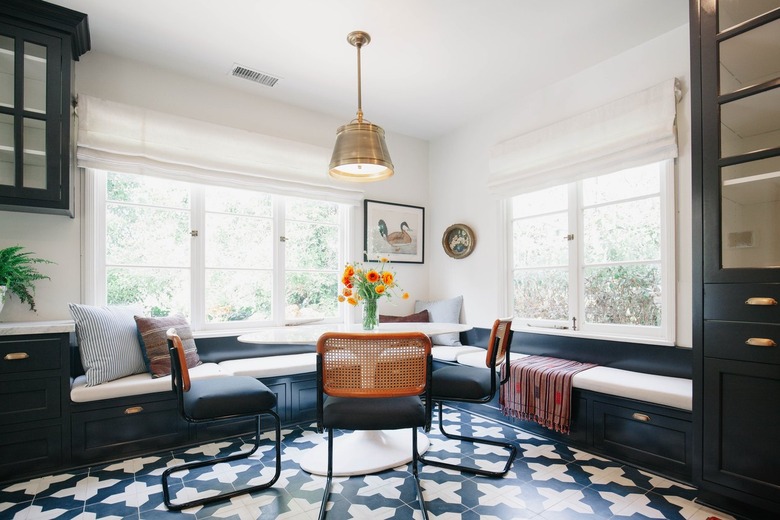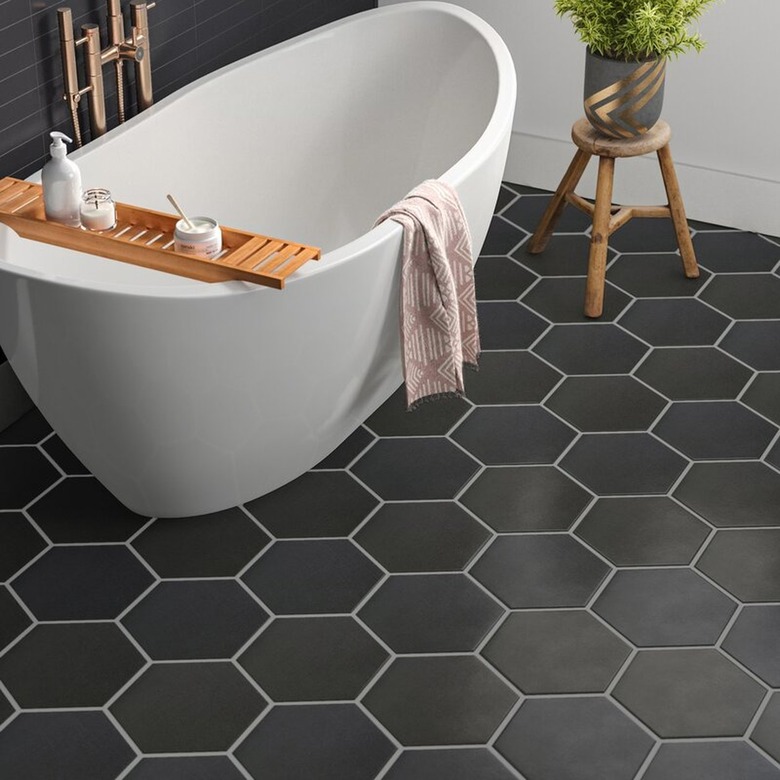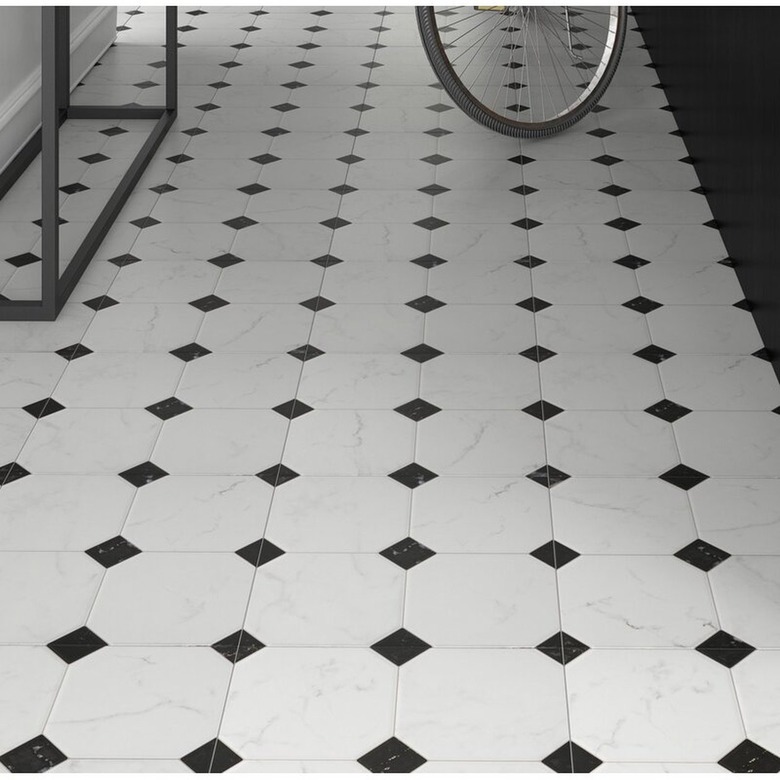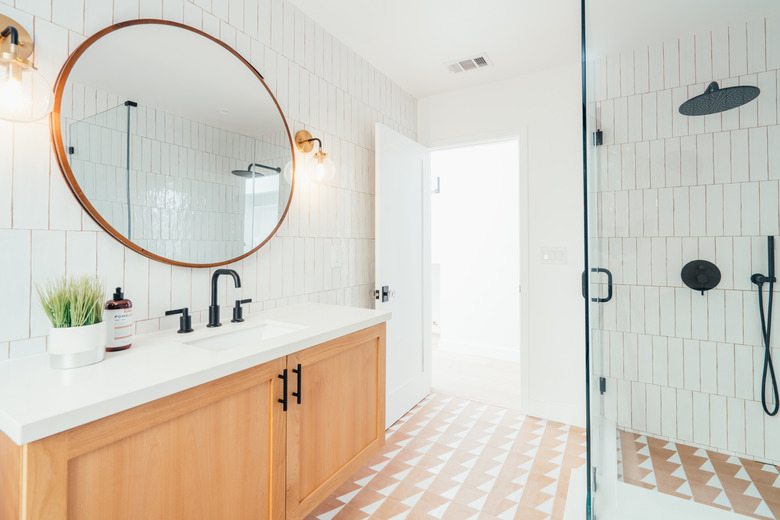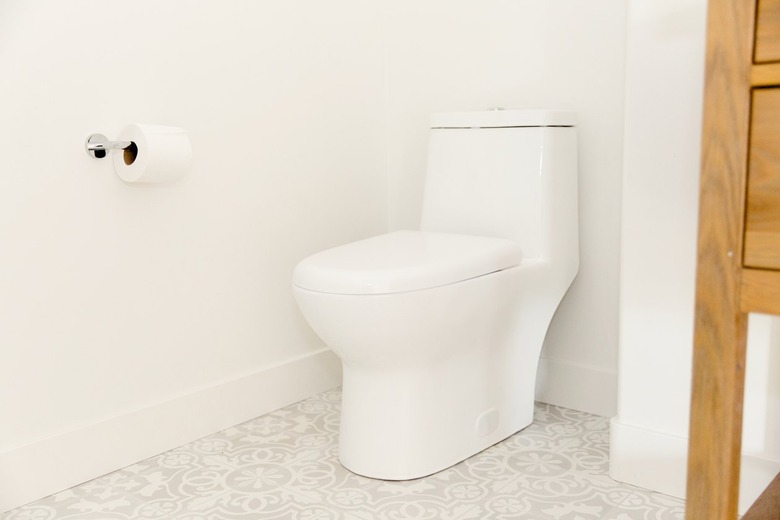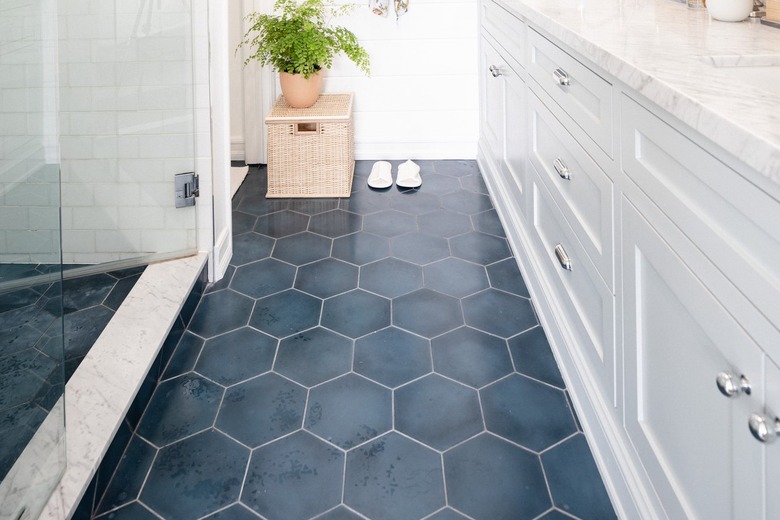Porcelain Vs. Ceramic Tile: What Actually Are The Differences?
- What is porcelain?
- What is ceramic?
- Porcelain vs. ceramic stain resistance
- Porcelain vs. ceramic water resistance
- Durability and hardness of porcelain vs. ceramic
- Life span of porcelain vs. ceramic
- Maintenance and repair of porcelain vs. ceramic
- Installation differences of porcelain vs. ceramic
- Aesthetic differences of porcelain vs. ceramic
- Which is better for your home?
If you're thinking about changing the floor tile in your home, there are many different options from which to choose. Two of the most popular options for floor tiling in your bathroom and kitchen are porcelain and ceramic tiles. Choosing one type of tile over another is not wrong or right but rather a matter of preference based on your needs, budget, and preferred tile style.
Before deciding which floor tile you prefer, it's helpful to have some background knowledge to wisely compare and contrast ceramic and porcelain. Though porcelain and ceramic may look similar on the surface, there are qualities unique to each type that may make one a better option for you than the other.
What Is Porcelain?
What Is Porcelain?
Porcelain is actually a type of ceramic tile made of sand, refined feldspar, and white clay. These materials are shaped into tiles and then fired in a kiln at very high temperatures to make the material hard and extremely dense. After it's fired, the porcelain is either left its natural color or glazed. Glazed tiles are available in a much wider range of colors, of course, but any chips or dings the tiles receive are more durable since the glaze color doesn't go all the way through the tile.
Porcelain tiles are quite impermeable and resist water well, making them a good choice for bathrooms and kitchens. They also hold up well when used outdoors. Porcelain can easily last 60 to 100 years, but it is expensive and somewhat brittle, which makes it difficult to cut during DIY installations.
What Is Ceramic?
What Is Ceramic?
Ceramic tile is made of clay, as is porcelain, but this clay can be red, white, or brown. It's not quite as refined as the clay used in porcelain. Like porcelain, ceramic tile is also fired in a kiln, but the kiln is kept at a lower temperature during the process. Ceramic tiles are less dense than porcelain tiles, and as such, they may absorb water if they aren't glazed. As a result, most ceramic tiles are glazed and are ultimately available in a much wider array of colors than porcelain tile.
Ceramic tile is less expensive than porcelain and slightly less durable, but you can still expect the tile to last 75 years or longer. You can only use ceramic tile indoors or in outside spaces where it will be relatively protected. Ceramic tiles will work better on a sunny Arizona patio than on a rainy Portland porch, but it's much less expensive than porcelain and easier to work with when installing it yourself. Ceramic is more porous than porcelain, so it works best in areas with low moisture levels. If you want ceramic in a damper area, make sure you choose a tile that the manufacturer deemed acceptable for that use.
Porcelain vs. Ceramic Stain Resistance
Porcelain vs. Ceramic Stain Resistance
Whether you live in a house with kids and pets, or you just consider yourself a bit of a klutz, when comparing the two tile types, it's important to consider how well porcelain and ceramic stand up to stains. The stain resistance of tile largely depends on the type of tile and its surface texture. Both ceramic and porcelain tile can be glazed or unglazed. In general, glazed tile is more stain-resistant because it has a hard, glasslike top layer baked into the tile material. Glazed ceramic and porcelain tile offer similar stain resistance.
Tiles with surface texture may or may not be more prone to stains than smooth tile, but textured tile is generally harder to keep clean because it has tiny nooks and crannies that can hold dirt. If you choose a textured tile, expect to scrub the tile surfaces more than what might be required with smoother tile.
Regardless of the tile type, the most vulnerable part of a tile floor is the grout, which often has a rough, porous texture that stains easily and is hard to clean. More advanced epoxy and other grouts are now available, however, and they are much more stain-resistant. Both ceramic and porcelain tile use the same types of grout. To add stain resistance, standard grout should be sealed with a grout sealer shortly after the tile installation. Sealer must be reapplied every few years depending on the product and the amount of traffic and wear the floor receives.
Two types of grout that do not need to be sealed are epoxy grout and premixed (acrylic) grout. Epoxy grout is difficult to work with and offers more strength than is necessary for most household floors. Premixed grout is more suitable than epoxy grout for DIY installation.
Porcelain vs. Ceramic Water Resistance
Porcelain vs. Ceramic Water Resistance
One of the reasons people choose tiling for their bathroom and kitchen floor is because these are the rooms that tend to experience higher humidity levels or at least different levels from the rest of the rooms in the home. In the bathroom, for example, there is a lot of moisture, and in the kitchen, there can be a lot of humidity.
These high levels of moisture would not work well with hardwood floors, for instance, because they readily absorb moisture and would get damaged easily. Tiles, on the other hand, whether porcelain or ceramic, hold up to water issues much better than most other types of flooring.
Because it is made from more refined clay and is fired at higher temperatures, porcelain is much more dense than ceramic. As such, porcelain is quite water-resistant on its own whether it's glazed or not. Ceramic, on the other hand, is more porous and likely to absorb water. Glaze makes the top of the tile water-resistant but may not protect the sides or bottom of the tile if you experience flooding. At the end of the day, however, porcelain is hands down the better choice where water and humidity are a concern. But even with porcelain you should remove spills and standing water as soon as possible.
Porcelain tiles are classified as impervious, meaning their water absorption rate is lower than 0.5 percent. Ceramic tiles are classified at three different levels of absorption. Nonvitreous tiles absorb water at a rate of more than 7 percent, while semivitreous tiles are rated between 3 and 7 percent. Vitreous tile absorbs water at a rate of 0.5 percent.
The very low absorption rate of porcelain tile makes it a better choice for areas with extremely high humidity, such as steam showers, and for outdoor use. Many types of porcelain are even rated for outdoor use, while most ceramic tile is not suitable for the outdoors.
Durability and Hardness of Porcelain vs. Ceramic
Durability and Hardness of Porcelain vs. Ceramic
Porcelain tiles are the toughest type of flooring you can get. They stand up to high-traffic areas, and because of their durability, they can be used in commercial settings, like factories or office buildings. A PEI rating refers to how well the flooring can stand up to foot traffic, and most porcelain tiles have a PEI rating between three and five, which is the highest rating.
Ceramic tiles are typically not as durable as porcelain tiles, and they usually have a PEI rating of three or four on average. Because there are porcelain tiles that have a PEI rating of less than five and ceramic tiles that have a PEI rating of more than three, it is possible to find ceramic tiles that are more durable than porcelain tiles, but in general, this isn't the case.
Ceramic and porcelain tiles are both pretty tough, but damage can happen. When it does occur on a glazed tile, however, the glaze and the exposed tile underneath will be different colors. This drives some people crazy. If you're one of them, opt for porcelain that is the same color throughout the entire tile.
Life Span of Porcelain vs. Ceramic
Life Span of Porcelain vs. Ceramic
If you're investing money in new tiles, then you'll probably want to ensure the flooring will last a long time. Since porcelain is much harder and more durable than ceramic, it will likely last longer. This is especially true given the fact that porcelain is also more difficult to install and remove. Because of this reason and because of the other qualities it has — like being able to stand up to water and stains more so than ceramic tile — it can have a long life span.
However, maintaining ceramic tile is easier, which can support a long life span too. The life span of the two is more or less the same, with ceramic tile actually having a slightly longer life span on average. Ceramic tile can last 75 to 100 or more years, while porcelain can last 60 to 100 or more years.
Maintenance and Repair of Porcelain vs. Ceramic
Maintenance and Repair of Porcelain vs. Ceramic
While both ceramic and porcelain tile can be maintained by sweeping and vacuuming (with the right vacuum and setting, of course), ceramic is actually easier to keep clean despite the fact that it is not as resistant to stains as porcelain. For a deeper clean, you can usually use vinegar and water to mop some types of porcelain tile, and for ceramic, you can use a mild cleaner or detergent mixed with water to get the job done.
In terms of repairs, unglazed tiles can get chipped, but it will hardly be noticeable. The same goes for glazed tiles in porcelain and ceramic. If there is chipping, you may see the original clay underneath, but it shouldn't be too noticeable. If you have a completely broken tile, you can remove it and replace it, though porcelain will be a bit more difficult to replace than ceramic. However, a broken tile is a lot less likely to happen with porcelain than ceramic due to its PEI rating.
If a small chip won't bother you or if you're willing to replace a chipped tile, ceramic and porcelain will both serve you well. If a chip is going to drive you crazy, though, go with a porcelain tile that is the same color all the way through.
Installation Differences of Porcelain vs. Ceramic
Installation Differences of Porcelain vs. Ceramic
The installation processes for porcelain and ceramic tiles are virtually identical, and both can be installed by DIYers. The only notable difference is that porcelain tile is somewhat harder to cut than most ceramic tile. While ceramic can be cut with a wet saw or manual tile cutters, such as a score-and-snap cutter, porcelain is best cut with a wet saw fitted with a diamond blade. Wet saws are commonly available for rent and usually come with a diamond blade; if not, you can buy a diamond blade for the project.
The average price for a tile job is around $1,833. The job can easily cost between $866 and $2,855, however, depending on the tile you choose and the square footage you're tiling. Expect to spend about $15 to $20 per square foot. Complicated installs with intricate patterns can cost much more, however. If you're doing a DIY install of porcelain, factor in the cost of renting a wet saw as well.
If you're working with a tight installation budget, ceramic tile is the winner hands down because it's easier to work with. If you're more concerned about longevity, you should seriously consider porcelain. Always remember to compare both cost and value when making home improvement decisions.
Aesthetic Differences of Porcelain vs. Ceramic
Aesthetic Differences of Porcelain vs. Ceramic
Though durability and moisture resistance are important factors, most people want to know how their new tile flooring is going to look in their home. So, which is better for the actual aesthetics? The answer is of course that it depends on what kind of look you're going for.
Ceramic tiles have a much wider range of available styles, so if you're aiming for a particular theme or color in your kitchen or bathroom then ceramic may be the way to go. Ceramic tile can also mimic wood flooring and stone flooring, which has become increasingly popular. Porcelain tile, on the other hand, can be cut into smaller pieces and create beautiful mosaics that ceramic pieces really can't be shaped in.
When it comes to aesthetics, there is no clear winner between porcelain and ceramic tiles. The right one for you is probably whichever one comes in the color and pattern that work best with your personal taste and home decor goals.
Which Is Better for Your Home?
Which Is Better for Your Home?
Ceramic and porcelain tiles both have their charm, but the best option for you depends on your situation. If you need to install your tile on a tight budget, ceramic can provide a better experience. It's less expensive, easier to install, and available in a much wider array of colors and design choices. It's a good idea to buy a few extra tiles, though, so you can replace a chipped or broken tile later if you need to do so.
Although both tiles are very durable, you may want to go with porcelain just in case things get a little hectic in your house. Porcelain is a bit more likely to withstand dropped pans or the occasional laundry room flooding thanks to its higher PEI rating. The choice between the two is largely a personal one, as the two do possess quite a few similar traits.
References
- BuildDirect: Porcelain vs. Ceramic Tile: What's the Difference?
- HomeAdvisor: How Much Does It Cost To Repair Ceramic Or Porcelain Tile?
- Floor Critics: Ceramic vs. Porcelain Tile Flooring
- EBOSS: Fire Ratings for Ceramic and Porcelain Tiles
- British Ceramic Tile: Ceramic Vs. Porcelain Tiles
- Fixr: Ceramic vs. Porcelain Tile
- Sebring Design Build: Porcelain vs Ceramic Tile: Which One Is Better
- HomeAdvisor: Porcelain vs. Ceramic Tile: Which Is Better?
